|
|||||||||||||||||||
|
|
|||||||||||||||||||
Results from Survey given in January 2005
There were 288 responses.
251 or 87% of the responses were from non-STScI employees
32 or 11% of the responses were from STScI employees
We solicited responses from all subscribers to the Archive Newsletter and to all those who had retrieved data from DADS in the previous 12 months. We also placed an invitation to participate in the survey on the MAST web pages.
The response rate is below that for two previous surveys (317 in 2002, 315 in 2003), but the ratio of Non-STScI Employees to STScI employees remained about the same.
With questions 1 through 7, we tried to characterize MAST usage and to determine the platforms and browsers MAST users are utilizing. The remaining questions attempt to solicit input concerning various tools and services MAST has either implemented or may plan to implement in the future. We provided several places for responders to enter comments and suggestions. These have been compiled and are also included in the listing. We would like to respond to some of the suggestions and comments. That response has been compiled in a separate web page. In some respects we find the comments the most useful part of the survey. We would really like to get these throughout the year as you discover needs or have questions. Please send them to the archive help desk at archive@stsci.edu or call at 410-338-4547 between 9:00 AM and 5:00 PM eastern time.
1. How often have you used MAST in the past 12 months?
| The frequency of MAST usage has stayed about the same over the past two years. There has been a slight upward trend in the percentage of users who use MAST a few times a week. More responders in 2005 had not used MAST in the past 12 months. |
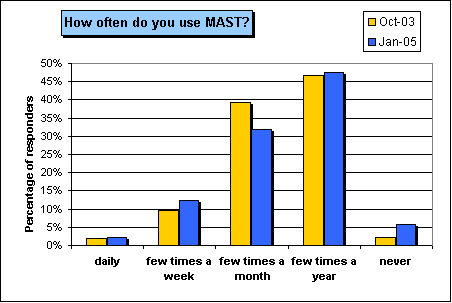
|
3. What missions did you access? (multiple choices permitted)
Of the 277 people who responded to this question in January 2005, 88 or about 32% use only HST. An additional 44 (16%) use both HST and the DSS. |
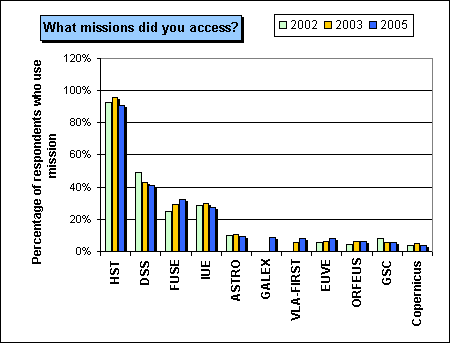
|
The archival data are being used. Of the 277 respondents who answered this question, 97 or about 35% indicated use of data from the IUE, EUVE, ASTRO, ORFEUS, Copernicus and VLA-FIRST datasets. This is slightly down from previous years. Obviously, archival data from the active missions are also being used but that information was not measured in this survey. |
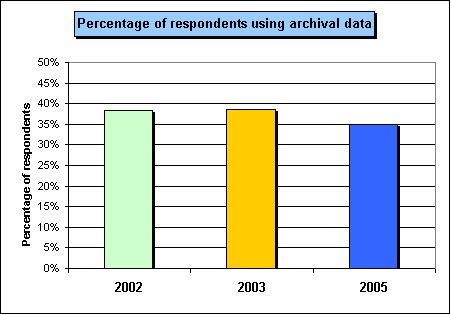
|
4. Which operating system do you primarily use to access MAST?
| In the 15 months between MAST surveys, there has been a movement away from the Solaris machines to both Linux and Mac OS X. |
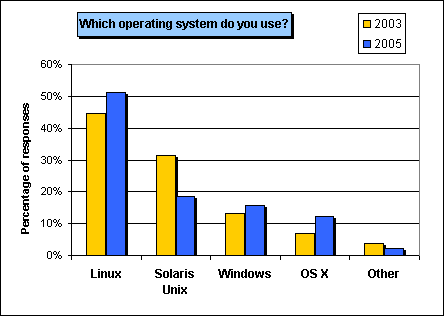
|
5. Which browser do you primarily use for your work?
|
Many of the "Other" Browsers such as Opera and KDE Konqueror decreased. It is probable that additional Firefox users chose the Netscape7/Mozilla options. In hindsight, the Mozilla/Netscape option should have been two different choices.
We try to make the web pages compatible with the most widely used browsers. It is very difficult to do anything but the most simple pages that are compatible with all browsers or with old versions of browsers. The MAST web pages are compliant with "HTML 4.01 transitional" and "CSS levels 1 and 2". Cascading style sheets (CSS) and JavaScript are used for controlling the appearance of the navigation links so be sure they are enabled in your browser. We are also in the process of verifying compliance with Priority 1 accessibility and section 508 compliance as defined at the Bobby web site. |
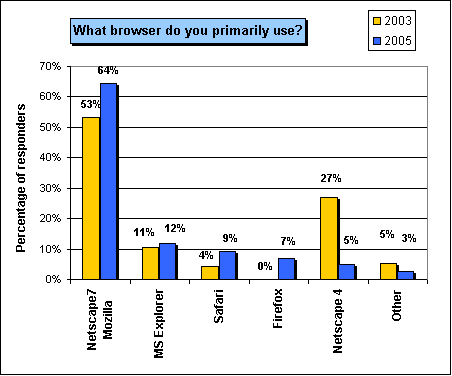
|
6. For what reasons do you use MAST? (check all that apply)
| While it is obvious that most users of the MAST archive utilize it for scientific research, we need to know what other reasons MAST is used for. |
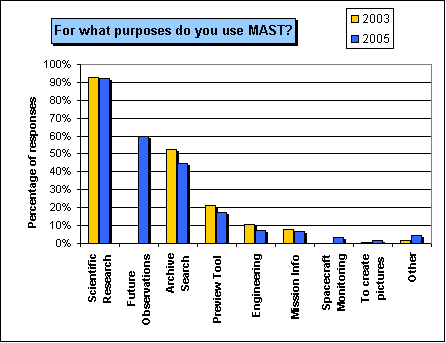
|
7. What is your primary and most common reason for using MAST?
| Even among STScI employees, Scientific Research was the primary reason for using MAST. Twenty of the 32 (62%) of the STScI employees who responded to the survey stated that Scientific Research as the primary reason for using MAST. |
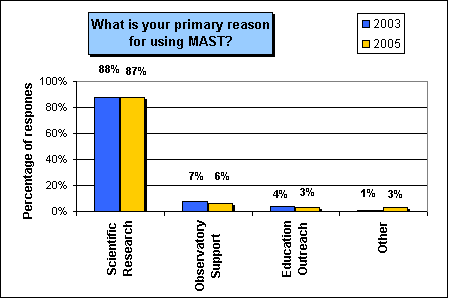
|
8. Over the past 12 months, which choice best describes your level of satisfaction with retrieval times for HST and FUSE data?
|
DADS performance has improved significantly over the past year. The majority of requests are filled within 1-2 hours.
Large requests of ACS data will take longer due to the processing time required to process the data.
While we did not ask this question in the last survey, the user comments made it quite clear that the performance of DADS was not at all satisfactory to our users. We hope and think that the improvements have made the satisfaction level significantly higher. |
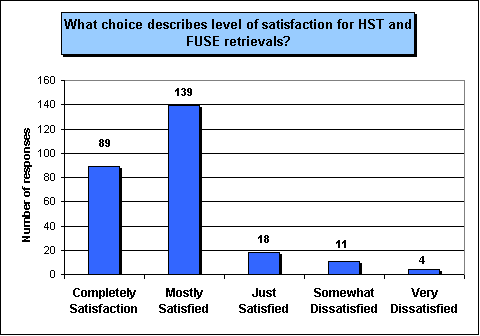
|
Comments about HST and FUSE retrieval times:
- sometimes it takes a while between the request and the retrieving of the data. I thus prefer the ST-ECF archive at ESO when possible
- Usually data is available <24hrs, but occasional week+ delays are unacceptable
- It takes too long to get the data all too often. I have had to get data from ST-ECF and similar sites quite a few times.
- Can't do much about transfer times, but it seems to take ages to process.
- I definitely prefer the 'IUE' way
- Takes a long time to get data delivered. Servers at STScI are often down.
- it would be nice if upgrades to the system/database could be carried out without downtime of the archive
- downtime announcements could be better updated, and more prominently displayed
- I have been completely satisfied because all requests have been obtained within one or two days.
- The system functions superbly!
- Close to 'completely satisfied' but I must be spoiled -- when a request takes a day or two, I now feel that it's too long... Very nice work.
- vast improvement over a yr ago, still not as quick as desired in an absolute sense
- retrieval time has improved significantly over the past 1-2 years.
- HUGE improvement over August 2003!!!
9. Which kind of documentation about MAST would you most like to have available?
| We currently have all three kinds of documentation about MAST, although the "Archive Handbook" is out-of-date and needs to be updated. We recently implemented a tutorial and plan to expand it. We have help pages associated with all interfaces. |
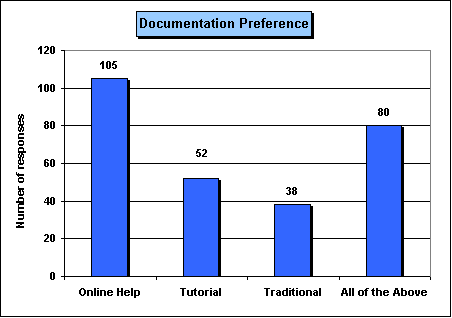
|
Comments about documentation:
- What if I only wanted two of the above three? I don't feel the need for a tutorial, but could find an electronic version of a paper manual (which I could then download) or online help pages useful.
- PDF is easiest to read onscreen and print
- I have always found the current forms rather easy to use. I have never actually tried to do anything complex though.
- thought it intuitive.
- I find that the pages are mostly self-documented, but my experience with other archives is that the more documentation that's available, the better; and the more that are available helps with accessibility ...and this in a consistent way!
- paper manuals in addition!
- A web-based tutorial wouldn't be particularly useful for me. Quick access to specific help information (through online help) could be good. If an electronic 'paper' manual were exceptionally well-organized, that would probably be best, but I imagine
would take much longer to put together.
- I would prefer that the MAST interface be sufficiently intuitive that manuals would not be necessary.
- context-based help is most useful, i.e. a column title linking to a 'what is this' description
- For very new kinds of services, the downloadable PDF file is most useful. For updates to existing services, I prefer to be able to find and read just the paragraph required to use it.
10. Which of the following are helpful for learning about new features or developments at MAST?
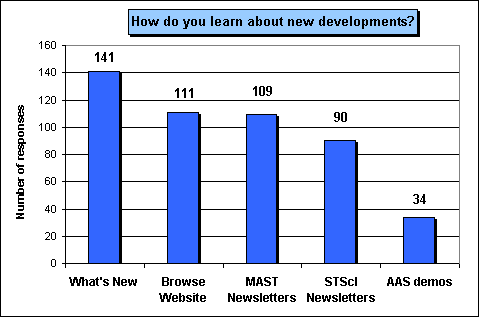 When we implemented the enhanced web pages in December 2004, we placed the headlines for the last few
What's New items on the main MAST page. Click on the headline to get a more complete description of
the news item. The longer description usually contains links to relevant web pages.
Items relevant to an individual mission or to all missions are on the main mission page.
We are hoping that this more prominent placement will make it easier for users to keep up with new developments.
What's New is also available as an RSS News Feed.
When we implemented the enhanced web pages in December 2004, we placed the headlines for the last few
What's New items on the main MAST page. Click on the headline to get a more complete description of
the news item. The longer description usually contains links to relevant web pages.
Items relevant to an individual mission or to all missions are on the main mission page.
We are hoping that this more prominent placement will make it easier for users to keep up with new developments.
What's New is also available as an RSS News Feed.
We correlated responses from this question with the responses concerning the VizieR tool to see if there was a correlation between the means of learning about new features and those who had not heard of the VizieR tool. There was no correlation between the preferred method of learning about new features at MAST and those who were unaware of the VizieR tool, which was announced with all the methods listed in the question. Around 20% of responders who found each type of notification helpful, were not aware of the VizieR tool.
Comments and suggestions about learning about new features:
- An email announcement of major changes or new things to active users
- An automated tip display when MAST main page is accessed might be helpful
- Website news is the most helpful
- special email/newletters focusing on new features
- MAST e-mail alerts
- There are new features?
- 'What's New' probably the most useful, together with an accessible archive of the earlier "What's New"
- something like an FAQ archive
- should have announced earlier on the old Archival retrieval web page that the new archival retrieval web page was encouraged
- user's forum
- When I get the newsletters, the STScI newsletter isn't so important. (Less timely.)
- When you use a tool that has been recently upgraded, you could be given an alert that there are new capabilities
11. Which of the following best describes how useful you find the VizieR/MAST cross correlation search?
| This service was introduced in January 2004. We hoped that it would be helpful to people searching for specific types of objects by easing the cross-correlation search between MAST holdings and catalogs. |
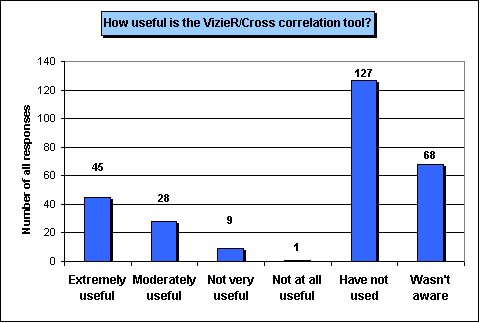
|
Comments and suggestions about VizieR/MAST cross correlation search:
| This plot shows the responses of those who had used the tool. |
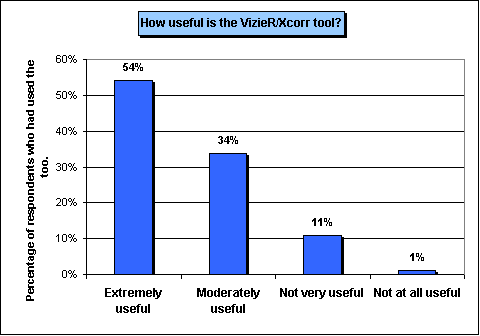
|
- I use it a lot
- not optimum for globular clusters
- To be useful to me, this service would need to be able to handle large cross correlations with restrictions, such as 'give me all HST images for galaxies in the RC3 having type in a certain range and redshift in a certain range.`
- difficult to use, frequently stalls, and returns results that are difficult to understand
- never used, certainly will use in the future
- good to know
- This is an extremely important feature to have working well, in my opinion. It would be nice if it could handle very large uploaded catalogs, though, and if the output wasn't hardwired to return null answers as well as positive matches. There is more that I would be happy to write in about.
- For some reason, perhaps limited by the Solaris Unix system installed in my department, some features in Vizier cannot be run properly. Even for the features that can be run, they are quite slow. I am not sure whether it is a problem with java-related programs run on Solaris system.
- I would LOVE to also be able to cross-correlate one Vizier catalog with another -- I haven't found a way to do that, and your site provides pretty good access to those catalogs.
12. Which of the following best describes how useful you find the Scrapbook tool?
| The scrapbook was designed to give a "quick-look" at the availability of data across MAST missions. |
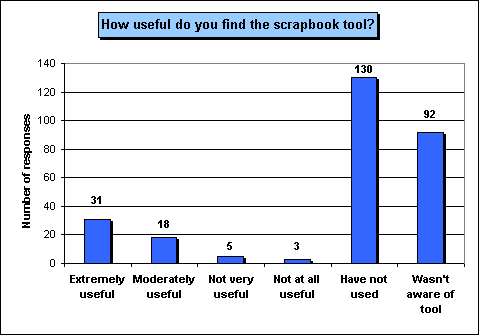
|
| This plot shows the ratings of usefulness among those who had used the tool. |
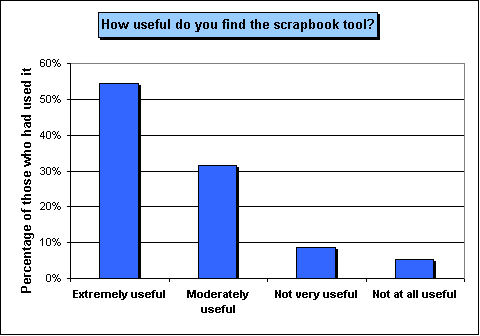
|
- but, this should be _very_ useful
- I'll try to explore this tool.
- would love to view previews of representative images or spectra of particular objects.
13. Which of the following best describes how useful you find MAST's High Level Science Products?
| The number of sets of High-Level Science Products (HLSP) available through MAST has been increasing over time. We actively solicit contributions from the science community. In time, HLSP from all HST Treasury and Archival Legacy programs will be available. HLSP are distributed via VO services. MAST welcomes contributions from the science community and if you are interested see the HSLP Contribution Guidelines. |
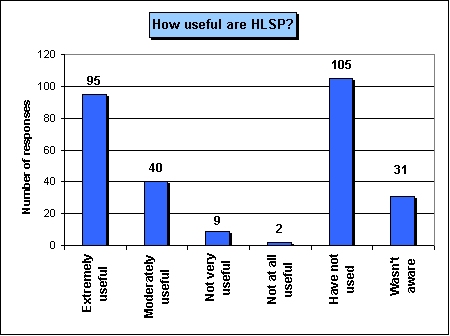
|
| This plot shows the ratings of usefulness among those who ranked the usefulness of the HLSP. |
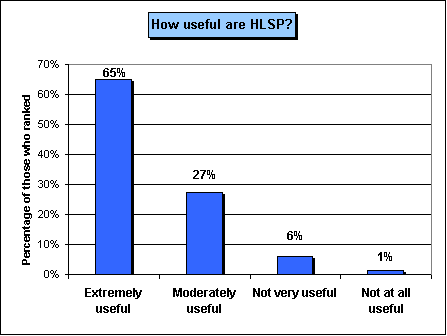
|
Comments and suggestions about High-Level Science Products:
- no time to reduce the data!
- Drizzle ruins photometry and resolution. These products are most useful for those who don't understand image processing.
- WFPC2 association do not seem to give access to all the products (e.g. .asn files) and I need to go to ESO/CADC sites for these
- Despite several requests for information, I continue to have unanswered questions about how the sky is computed and subtracted from WFPC2 Association data. The lack of detailed documentation on the Association data pipeline makes the resulting data products much less useful than they should be.
- HLSP are not available for all datasets, e.g. not all WFPC2 datasets have a HLSP...why?
- Useful for STIS, have not used for FUSE since these are usually old pipeline reductions
- encourage more PIs to provide HLSPs (for key projects), advertise their existence and value better
- Not present for enough data-sets
- searching the WFPC Association object lists is basically impossible as far as I can see.
- Doesn't seem like many of these datasets have been delivered.
- find that I often need non-standard processing.
- often need to reprocess data myself anyway (unsupported modes, poor pipeline processing).
- An excellent resource. The more the better!
- The most important and highest-level products, catalogs, are not well supported. Vizier & SDSS are the relevant standard in this area.
- only useful if the data are recognised as being associated, so for eg. POSTARG shifts don't get added
- often have to redo processing for even slightly non-standard obs (e.g. combining multiple visits)
- Excellent for bandwidth overlay imaging
14. Which of the following describes how important you think it is for MAST to make its holdings accessible using the standards developed by the NVO?
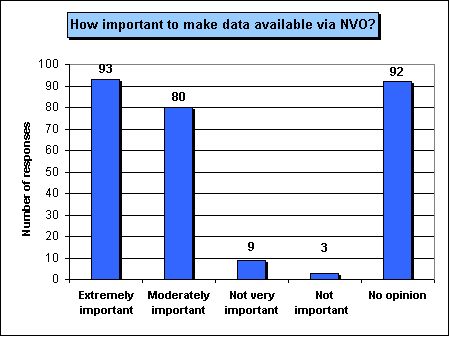 We understand some of the uncertainty and skepticism about
NVO, as much of the NVO work in the past few years has focused on standards
developments and prototypes. However, we believe it is increasingly
important for researchers to be able to easily locate, compare, combine, and
analyze data from a variety of instruments and from all parts of the
spectrum. We certainly want to make MAST data sets available to the NVO.
Our experience thus far is that there is relatively little work to do in
implementing VO interfaces. VO compatibility will not come at the expense
of other MAST services, but rather will be an enhancement and provide for
alternate access paths. Finally, the NVO released a first suite of
applications for general use in January. See http://us-vo.org for links.
The NVO Registry, DataScope, and OpenSkyQuery tools have access to MAST data
collections and make it easy to compare with other data. The Spectrum
Services package includes filter transmission functions for most HST
instruments. You can do object detection on MAST or other images with
SExtractor without having to install SExtractor on your own system, and
automatically cross-match the object list with one SDSS, 2MASS, and other
large survey catalogs.
We understand some of the uncertainty and skepticism about
NVO, as much of the NVO work in the past few years has focused on standards
developments and prototypes. However, we believe it is increasingly
important for researchers to be able to easily locate, compare, combine, and
analyze data from a variety of instruments and from all parts of the
spectrum. We certainly want to make MAST data sets available to the NVO.
Our experience thus far is that there is relatively little work to do in
implementing VO interfaces. VO compatibility will not come at the expense
of other MAST services, but rather will be an enhancement and provide for
alternate access paths. Finally, the NVO released a first suite of
applications for general use in January. See http://us-vo.org for links.
The NVO Registry, DataScope, and OpenSkyQuery tools have access to MAST data
collections and make it easy to compare with other data. The Spectrum
Services package includes filter transmission functions for most HST
instruments. You can do object detection on MAST or other images with
SExtractor without having to install SExtractor on your own system, and
automatically cross-match the object list with one SDSS, 2MASS, and other
large survey catalogs.
Comments and suggestions concerning MAST participation in the VO initiative:
- Much depends on how the VO develops.
- I haven't seen what the VO can do for the scientist that isn't done already
- More important in long run, not very urgent yet
- VO is merely a buzzword at this stage.
- Haven't used VO (Never seems very useful)
- This will be very important later, once these standards are developed and do useful things. Of course MAST needs to be used today to solve actual problems right now, and so one must be careful about how much priority to put on VO services.
- As long as I am able to easily and cleanly access data and information, I am happy. I don't know enough about the ease or difficulty of adopting VO-standards to know how worthwhile the effort would be.
- Was unaware of VO capabilities, will check them out; still like the 'old' MAST stds as am comfortable with them.
- depends on whether VO turns into something that is really viable, if so very important
- I have yet to see what the requirements would be on MAST to make it's holdings accessible to the NVO, but from what I understand about NVO (which admittedly isn't much), it would seem strange not to have data from one of the most important scientific tools in history as part of the NVO.
- It's the wave -- ride or become passe, eh?
- MAST should set the standards
- The VO should be able to query MAST and obtain the information and place it in a format it requires. There could be a VO interface to MAST but that is likely a waste of man hours and possibly duplicate work done elsewhere.
- VO compatibility is important for the future, so long as the VO formats are easy to ingest by the end user; I haven't spend much time researching this yet.
- Adhering to standards makes data acquisition routine, once you figure out the standard. NVO is and will become a portal and a standard of standards.
- Explanation: that opens new perspectives to any scientific project by a real opportunity to access more data.
15. MAST has already made progress integrating services with VO. Please check the existing services listed below that you are aware of.
|
There were 91 people who were aware of at least one of the services.
The comment that "VO tools are behind the scenes" is largely correct, and that is by design. However, as the number of astronomical archives, catalogs, and databases accessible through VO interfaces continues to grow (there are now over 5000) we expect that users will see more information formatted as VOTables, and images and spectra will be delivered more frequently through the VO Simple Image Access and Simple Spectra Access Protocols. Tools such as VOPlot, Topcat, Mirage, Aladin, and OASIS all understand the VO formats and can make direct use of VO-delivered datasets. |
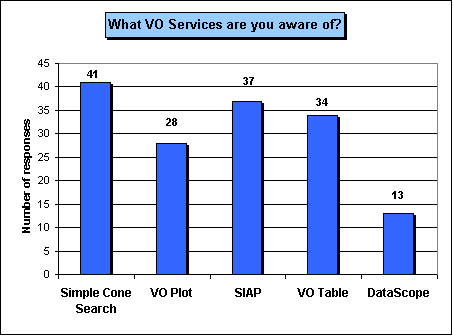
|
Comments about the progress MAST has made integrating services into VO:
- Aware of these but don't use them
- All of these seem helpful for finding data on one specific target, but it appears to be difficult to use to find data on a class of objects that I can describe in terms of catalog parameters like galaxy type, redshift, size, distance, magnitude, etc.
- I have seen references to VOTable formats in the queries, but it's not my preferred viewing or download format yet
- VO tools are often 'behind the scenes' -- it's less important that the user KNOWS they're using a VO-enabled service than the fact that they're using it at all. It seems as if this list, the unfamiliarity I have is with the VO service itself, not that that VO service can use MAST.
16. What other data centers do you access regularly?
| The initial set of responses listed only other multi-mission archives or integrating services (HEASARC, IRSA, LAMBDA, NSSDC, ADS & NED) that are funded by NASA. Other archives and services were entered by users. Probably more users would have indicated these other archives and services if they had been listed in the original question. |
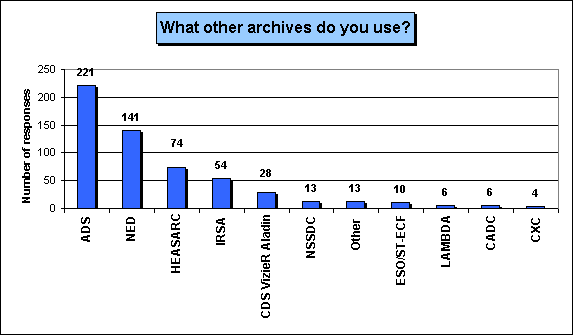
|
If applicable, please tell us about how you find MAST in comparison with other NASA data centers in terms of ease of use and services available. Are there features you find useful at other centers that you would like to see implemented within MAST?
- MAST compares very poorly with the other NASA data centers. The service is often unreliable and the retrieval times are sometimes unacceptably high. Recently, the Digitized Sky Survey data were unavailable when they were needed to help prepare Cycle 14 HST proposals.
- Other services are quicker and more reliable. It also seems like they have more scientific oversight. The existing MAST services aren't very useful, and retrieval times are too long!
- Downloading a data from MAST was more complicated than HEASARC. It was a good idea to put the data into a user given ftp address but complicated.
- When I search for an object in NED, I get a selection of images on one page for several different wavelength ranges. I find that very useful for deciding what instrument archive I even want to search.
- I think it's pretty good - thanks. As noted above, closer links to relevant docs for non-mission-experts (like me) could be useful.
- Fine, sometimes better (for simple searches of Vizier catalogs, your interface is better than the native Vizier search tool). The Galex service is sufficiently different from everything else you do that I think it could use a thorough documentation and much more user feedback.
- MAST has improved a lot over the past year, and I am a heavy user for FUSE, HST, and IUE. The latter is very good since one can download HLSP essentially instantly, more-or-less the way that the X-ray archives work. FUSE and HST usually take much longer, sometimes overnight turnaround on moderate requests. instant gratification would be better for pursuing hot science topics or for preparing observing proposals the night before they are due...
- East of use and services is very good at MAST. Most services that I need seem to be available, but it would be nice to have a footprint service that returns lists of images that contain a given RA,Dec position within the image boundaries (which is particularly important for WFPC2).
- I think the MAST archive is the most convenient tool I've used to download data once I've found it in the archive. Searching for HST solar system data is too cumbersome.
- MAST offers excellent support, with effective search and preview tools, and prompt and flexible means of returning data products. MAST is to be highly commended for an excellent job, and for continuing to improve an already extremely vital product.
- It is very helpful to me that MAST has search forms for both a single target and a file of many targets.
- Comparable in easy of use and usefulness.
- MAST is easy to use and very useful. No other data center which I've used is better. My thanks and compliments.
- I just became aware of MAST looking for data on clusters of galaxies. I find it user friendly and well documented. MAST certainly keep up with the high standards that are seen in other NASA data centers.
- MAST is excellent, especially distribution on to DVD. Saves a lot of time and easy to use and store data. Please continue this service. Most grateful for data.
- All archive services all good to me, MAST is certainly at the level ones expect from a archive service. Easy to understand and access, powerful.
- I consider MAST to be the forefront in data distribution - and is always concerned about the 'end-user'.
How can we do a better job supporting your archive needs? Please provide any comments, concerns, or suggestions in the space below:
The responses to this question are broken into broad categories: General comments, Searches, Retrievals, Previews, HLSP, and Documentation.
General Comments
Previews
Retrievals / Processing
Searches
|
|
|




 Follow Us
Follow Us